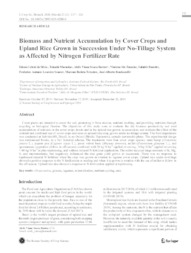Biomass and nutrient accumulation by cover crops and upland rice grown in succession under no-tillage system as affected by nitrogen fertilizer rate.
Biomass and nutrient accumulation by cover crops and upland rice grown in succession under no-tillage system as affected by nitrogen fertilizer rate.
Autoria: SILVA, E. C. da; MURAOKA, T.; BASTOS, A. V. S.; FRANZINI, V. I.; BUZETTI, B.; SOARES, F. A. L.; TEIXEIRA, M. B.; BENDASSOLLI, J. A.
Resumo: Cover plants are intended to cover the soil, protecting it from erosion, nutrient leaching, and providing nutrients through recycling or biological fixation. The objectives of this study were to evaluate the dry biomass productivity and total accumulation of nutrients in the cover crops shoots and in the upland rice grown in succession; and evaluate the effect of the isolated and combined use of cover crops and urea on upland rice crop, grown under no-tillage system. The field experiment was conducted at Selvíria-MS, Brazil, in an Oxisol (Rhodic Haplustox), cerrado (savannah) phase. The experimental design was randomized blocks, in a 5x3 factorial scheme. The treatments were four cover crops species: sunn hemp (Crotalaria juncea L.), pigeon pea (Cajanus cajan L.), green velvet bean (Mucuna prurens), millet (Pennisetum glaucum L.), and spontaneous vegetation (fallow in off-season) combined with 20 kg N ha-1 applied at sowing, 20 kg N ha-1 applied at sowing + 60 kg N ha-1 at plus topdressing, and without mineral N fertilizer application. The millet recycled large amounts of K, Mg, S, and micronutrients, but negatively influenced the rice grain yield grown in succession. There was no response to topdressed mineral N fertilizer when the crop was grown in rotation to legume cover crops. Upland rice under no-tillage showed a positive response to the N fertilization at seeding and when it is grown in rotation with the use of millet or fallow in the off-season. Upland rice also showed a response to N fertilization applied at topdressing.
Ano de publicação: 2020
Tipo de publicação: Artigo de periódico
Unidade: Embrapa Cocais
Palavras-chave: Arroz, Arroz Sequeiro, Biomass, Biomassa seca, Cajanus Cajan, Crotalária Juncea, Grasses, Legumes, Mineralization, Mucuna prurens, Nutrient cycling, Oryza Sativa, Pennisetum Glaucum, Urea
Observações
1 - Por padrão são exibidas publicações dos últimos 20 anos. Para encontrar publicações mais antigas, configure o filtro ano de publicação, colocando o ano a partir do qual você deseja encontrar publicações. O filtro está na coluna da esquerda na busca acima.
2 - Para ler algumas publicações da Embrapa (apenas as que estão em formato ePub), é necessário ter, no celular ou computador, um desses softwares gratuitos. Sistemas Android: Google Play Livros; IOS: iBooks; Windows e Linux: software Calibre.
Acesse outras publicações
Acesse a Base de Dados da Pesquisa Agropecuária (BDPA) para consultar o acervo completo das bibliotecas da Embrapa.

